

Whether You Need A New Weber Charcoal or Gas Grill
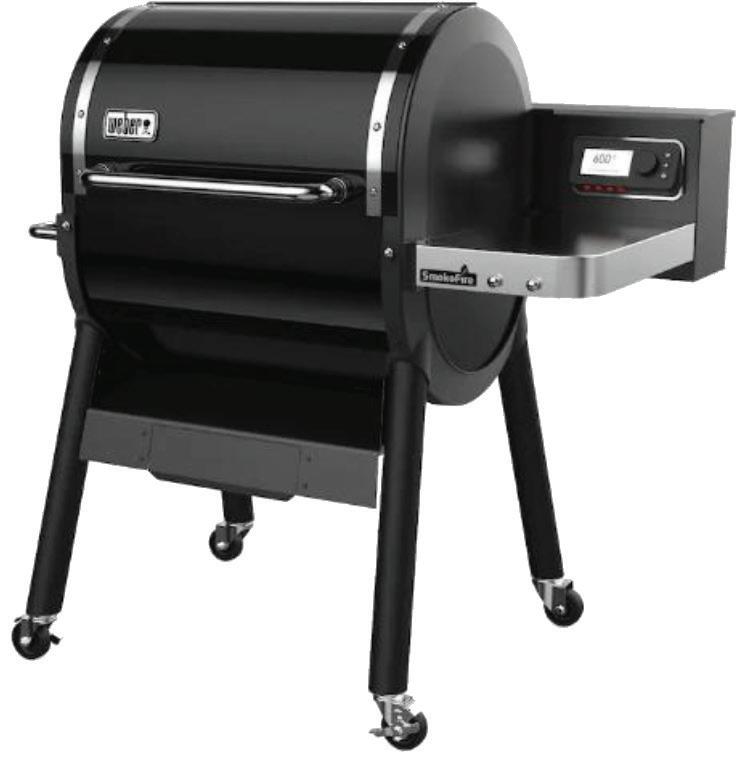




















What consumers can do to support
Farming has never been a vocation for individuals looking for easy work. Farmers typically work long hours, braving the elements regardless of how unpleasant the weather may be.
All that hard work ensures individuals who live in rural, urban and suburban communities have constant, readily available access to healthy foods. Such devotion merits support, and thankfully there are many things consumers can do to show their appreciation for local farmers.
BUY AT LOCAL FARMERS MARKET
Farmers markets are many foodies’ favorite places, but they aren’t exclusive to individuals with a passion for food. Everyone needs to eat, so why not eat foods grown locally, which are generally more fresh and appetizing than imported fruits and vegetables sold at chain grocery stores?
Even individuals who don’t typically eat fresh fruit and vegetables can find something delectable at a local farmers market, where anything from homemade tomato sauces to locally raised fresh beef and pork might be on sale.
ORDER DIRECTLY
Some farmers have embraced the e-commerce revolution and begun selling


the foods they grow to consumers via their own websites. Research local farms and determine if it’s possible to buy directly from them. Farms may offer delivery or pick-up, and consumers can enjoy fresh foods even more knowing that they helped farmers earn higher profits by buying directly from them.
CHECK LABELS
Packaging labels will indicate where fruits and vegetables came from. When possible, choose items produced by local farmers. This may include fruits, vegetables, meat, pork, or even desserts like pies. Locally produced foods often taste fresher than items sent from overseas or distant farms, and consumers will feel better knowing they helped to support local farmers.
SPREAD THE WORD
Get the word out after a satisfying experience with local farms and farmers. Whether it’s buying food from farms or taking advantage of family days that let kids enjoy a day on the farm, sharing positive experiences via social media or word-of-mouth can be a great way to inspire your neighbors to support local farmers as well.
(METRO CREATIVE)
above: Consumers can do much to support hardworking local farmers. In addition to feeling good about supporting their rural neighbors, consumers also might feel good when they sit down and enjoy a meal featuring locally grown, fresh foods.
FILE PHOTO Fresh from the Farm
FARMERSMARKET
Area farmers markets bloom each May and June throughout the area and continue through the fall harvest.
The markets offer a variety of products, but none so sought after as the fresh produce from local farms, grown within hours, sometimes minutes, from the table.
Area residents can purchase fruits and vegetables grown locally, including some from certified organic farms.
Pasture-fed and organic meats are also available at some markets, along with raw honey. Herbs and flowers round out the overwhelming selection, along with homemade soap, teas, nuts, wild rice, eggs, specialty coffee, crackers, sauces, maple syrup, kettle corn, mushrooms, sausage, and cheese.
Bright-colored canopies blossom on town squares, in shopping center parking lots, and in scenic parks along rivers and
lakes. The season typically runs May through October, although opening and closing dates vary by location.
According to market devotees, food from the surrounding area is fresher and therefore tastes better. There’s no comparison between a tomato picked green and trucked hundreds of miles to one picked ripe and bursting with the flavor of the land.
Fresh, locally grown plants, produce and products are available at farmers markets throughout the area.
Here’s a listing of the locations, dates and times of some of those markets:
BURLINGTON
The Burlington Farmers Market is at Wehmhoff Square on the corner of Washington and Pine streets and runs Thursdays from 3 to 7 p.m. through Oct. 26.
The market offers a large selection of produce and locally sourced items and the opportunity to interact with the producers. There is also live music. For more information, visit www. burlingtonwifarmersmarket.com.
DELAVAN
Delavan’s Fresh Market runs from 3 p.m. to 6 p.m. Thursdays, June 1, through Aug. 31 at Tower Park, 117 Park Place, Delavan

EAST TROY
The East Troy Farmers Market is on the first Friday of the month at East Troy Village Square Park, 2881 Main St.. Hours of operation are 4 to 7 p.m. June through September during the East Troy Area Chamber of Commerce’s First Fridays events.
The market features vendors selling
For Weekly Specials on Your Inbox TEXT WILSON to 42828 438449
Visit the We bring the finest quality farm-fresh meats to your table 406 S. Wisconsin St., Elkhorn, Wisconsin 53121 (262) 723-2919 • www.wilsonfarmmeats.com 436700



homegrown and local produce, specialty items, meats, honey, cheese, flowers, crafts and more. The event also includes live music and featured weekly activities.
ELKHORN
Saturdays on the Square runs from 9 a.m. to 1 p.m. on the downtown Elkhorn Square.
The open market is held Memorial Day weekend through Labor Day weekend and features fresh produce, vendors, crafters, food, entertainment and more.
For more information, visit www. elkhornchamber.com.
MUKWONAGO
The Mukwonago Farmers Market runs from 2 to 6 p.m. every Wednesday until October in Field Park, on the corner of highways 83 and NN.
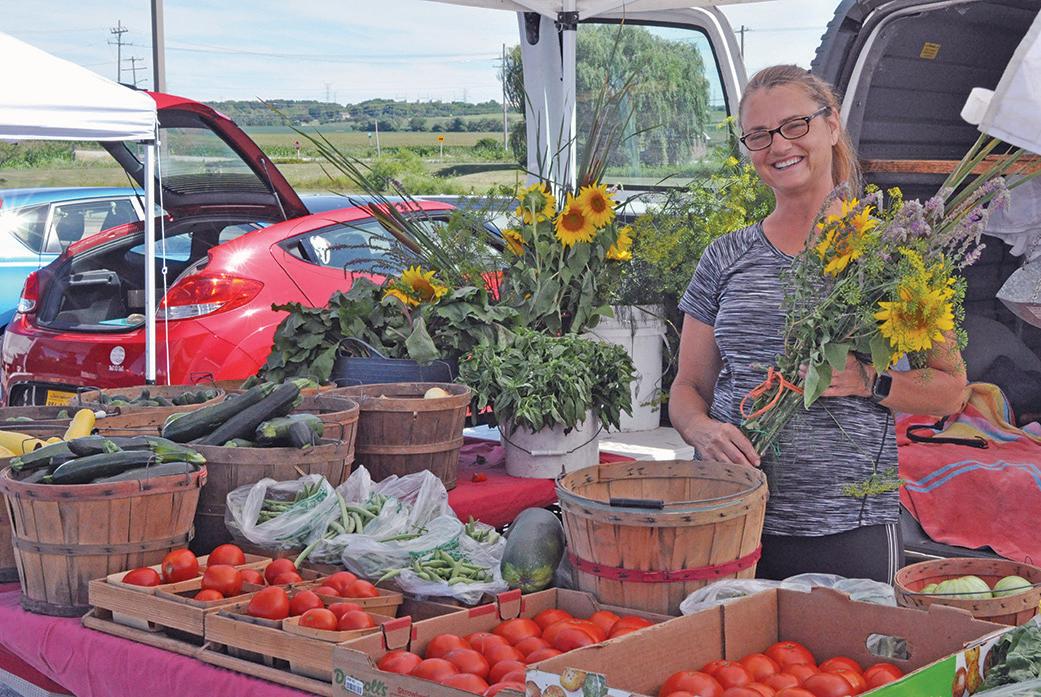
The market features fresh produce, food vendors, live music and more.
TWIN LAKES
The Twin Lakes Farmers Market is
open the first and third Sunday of the month during summer at 213 S. Lake Ave. from 9 a.m. to 1 p.m.
LAKE GENEVA
• The Lake Geneva Farmers Market is 8 a.m. to 1 p.m. every Thursday through Oct. 27 at Horticultural Hall, 330 Broad St.
• The Geneva Outdoor Market is held Saturdays from 9 a.m. to 1 p.m. at 3252 Highway H, Lake Geneva. The market runs through Oct. 29.
UNION GROVE
The Union Grove Public Market runs June \through September on Tuesdays, from 2:30 to 6:30 p.m.
WHITEWATER
The Whitewater Farmers Market is open every Saturday from 8 a.m. to noon through October in the Depot Museum parking lot, 301 W. Whitewater St.
The market includes a variety of fresh, locally grown fruits and vegetables, baked goods, honey and preserves,
flowers, shrubs, birdhouses and jewelry. The Whitewater City Market is held every Tuesday through October from 4 to 7 p.m. at the Train Depot Museum, 301 Whitewater St.
WILLIAMS BAY
The Williams Bay Farmers Market runs 8:30 a.m. to 1:30 p.m. Fridays at Edgewater Park, East Geneva Street, Williams Bay. The market will run through Sept. 1.
PALMYRA
The Palmyra Makers Market is new this year and runs \Mondays from 5 to 8 p.m. on Taft Street between Second and Third streets through Sept. 25.
Visitors will find fresh, locally-grown produce, hand-crafted, and one of a kind items. In addition, the market will offer specialty food items including Mr. P’s Grilled Cheese food truck, and ice cream and specialty coffee at CJ’s Coffee n’ Cream.
For more information, call 253-3809036.
The demand for food is directly related to population growth. By 2050, food needs are expected to double, according to a study published in the journal Agricultural Economics. That puts increasing pressure on the agricultural sector to meet growing demand. However, many experts think the industry will fall short.
In addition to increased food demand, consumer habits, technology, and policies continue to force the agricultural industry to evolve. Indeed, the agricultural sector may look very different in the future.
BIGGER DIGITAL FOOTPRINT
Social media has transformed many industries, and it can do the same for agriculture. Farming supply chains can communicate with one another by getting feedback from customers in real time through social media. However, agricultural operations will have to devote teams to manage social media presence, especially since misinformation
is so widespread on social media.
Apart from social media, local farmers may increase their efforts to utilize mobile apps and direct-to-consumer purchasing options. The global pandemic helped businesses reimagine takeout and curbside shopping.
Local farms may want to market to the home-shopping community, providing ways to deliver produce, fresh meat and poultry and other items direct to customers’ homes.

REGENERATIVE AGRICULTURE
The future may feature a significant shift in the way farms source their ingredients. Regeneration International says that regenerative agriculture can be the future.
This describes farming and grazing practices that may help reverse climate change by rebuilding soil organic matter and restoring degraded soil biodiversity. Some insist that farmers who utilize regenerative agriculture produce food
that is more sustainable and healthy. This is something eco- and health-conscious consumers can stand behind.
TECHNOLOGICAL ADVANCEMENT
There’s a good chance that technology will continue to play important and growing roles in farming operations. New agricultural technologies can collect data on soil and plant health and produce results in real time. Precision farming technology can be developed to deliver integrated solutions no matter the size of the operation.
SHIFT IN WHAT’S GROWN
Farmers may give more thought to sustainable products. Crops like hemp and cannabis are being utilized in new and innovative ways, and they’re only the start as consumers have expanded their views on plant-based foods and products.
(METRO CREATIVE)Grilling time!
Ideas to make those farm-fresh ingredients sizzle!


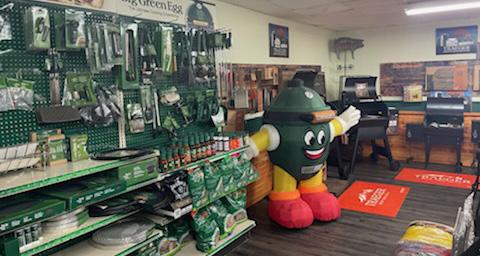




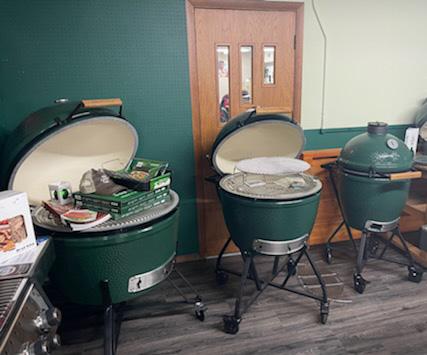

Big Green Egg among inventory highlights
By Jason Arndt STAFF WRITERLyle’s TV & Appliance, of Elkhorn, has been in business for decades and offers multiple household options for consumers looking to fill their home and even on the outdoor patio.
While the Elkhorn-based business has several items in stock, such as refrigerators, televisions, dishwashers, ovens and stoves, and other items, Lyle’s also touts a diverse range of outdoor grilling options.

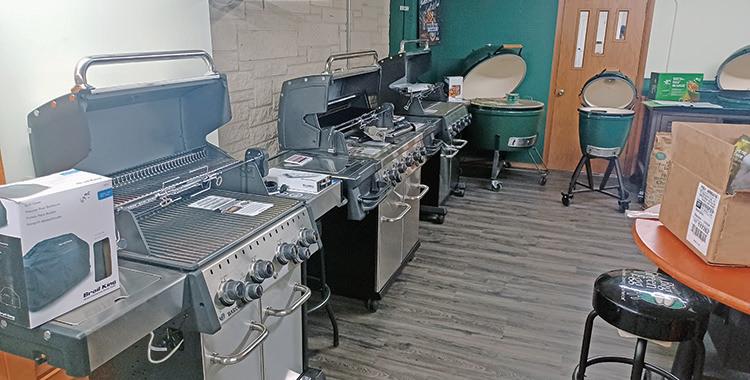
Lyle’s President Thomas Schinke said the company has gas grills, pellet grills manufactured by Traeger and other key distributors, as well as wood fire pizza ovens.
“We have got a little bit of everything for everybody,” he said. “We sell everything from low end to high end. We are price competitive.
Schinke added his business offers grilling options designed to last decades.
Within the last decade, meanwhile, Lyle’s introduced the highly touted Big Green Egg to its customers.
The Big Green Egg, which launched nearly 50 years ago in Atlanta, is sold exclusively at independent retailers such as Lyle’s.
Mike Essman, Big Green Egg account manager for Wisconsin and Iowa, said the company’s relationship with brick and mortar stores is highly important.
“We started as a small business in 1974 in Atlanta and we continue to maintain that relationship with independent dealers throughout the world,” he said. “We support the independent retailer. That is very important to this company with the brick and mortar stores, the stores like Lyle’s.”
HIGHLY POPULAR
The Big Green Egg initially became popular in the Southern and Western regions of the United States.
Since then, people from around the world have become attracted to the Big Green Egg for its versatility, Essman said.
“It is the versatility of it, it is not just a grill, it is an experience is what it is. It is a smoker, it is a grill, it is an oven.”
The Big Green Egg, which has a ceramic shell and can withstand frigid Wisconsin temperatures, offers precise and accurate temperature control features for consumers looking to prepare any type of food outdoors.
“I can run the temperature from 180 to 1,200 degrees any time of the year,” Essman said.
Additionally, Essman said the Big Green Egg comes with a lifetime warranty, primarily for the ceramic shell.
While the Big Green Egg offers versatility, the product comes in several sizes, but Essman noted consumers should consider how many people they plan on serving food.
“We have seven different sizes available and it all depends on how many people you are cooking for,” he said. “You want to make sure you have the room.”
Although the Big Green Egg is extremely heavy, the mini eggs can serve as an ideal size for people looking to use the product for tailgating, since the mini egg comes with handles.
Unlike the typical gas grill, the Big Green Egg comes with simplicity.
Essman said the Big Green Egg needs minimal, to low maintenance, and can be easily cleaned.
The price of a Big Green Egg is $695 and up, Essman said.
Schinke said Lyle’s sells 75 to 100 Big Green Eggs on annual basis.
“I started with one Big Green Egg about six years ago, now I have three of them at home,” Schinke said. “I also have a Traeger.”
For more information on Lyle’s TV & Appliance, 17 S. Washington St., Elkhorn, visit its website at lylestv.com.
MORE ON THE GREEN EGG
According to the Big Green Egg website accessible at biggreenegg.com, the appliance offers high-temp grilling of steaks, burgers, grilled fish, can roast poultry, lamb, beef and vegetable.
The insulating ceramics allows consumers to prepare food for low and slow smoking of meats.
Essman noted the the appliance comes with several accessories designed to improve cooking experiences and has multiple racks to place food.
“We have been standing behind our products for over 40 years,” the website states. “When you invest in a Big Green Egg, you will take home the highest quality outdoor cooker ever made.”
VENISON BURGERS
Serves 8
2 pounds venison meat
1/2 pound pork shoulder
1/2 pound slab bacon
1 Tablespoon Worcestershire sauce
1/2 teaspoon onion powder
Pinch of cayenne pepper
1/2 teaspoon garlic powder
2 Tablespoons Dijon mustard
2 teaspoons hot sauce
1 teaspoon kosher salt
1/2 teaspoon freshly ground black pepper
Optional toppings: Bacon, cheddar cheese, guacamole
A SPECIAL TWIST ON A CLASSIC FOR THIS YEAR’S JULY FOURTH BARBECUE
The Fourth of July may not be governed by official rules mandating celebrants attend a backyard barbecue before being awed by a nighttime fireworks display, but each of those things features prominently in many Independence Day celebrations.
Fireworks are best left to the professionals, but anyone can master the art of grilling delicious burgers and hot dogs.

Traditional burgers are made with ground beef. However, curious grillmasters can explore the many ways to experiment with burgers without sacrificing flavor. This recipe for Venison Burgers from “Texas Favorites” (Gibbs Smith) by Jon Bonnell utilizes venison and pork in lieu of beef. The result is a mouthwatering burger worthy of inclusion in any Fourth of July festivities.
(METRO CREATIVE)

Putting quality on the barbecue Specialty stores offer grillers a treat
 By Jennifer Eisenbart STAFF WRITER
By Jennifer Eisenbart STAFF WRITER
The grilling season has arrived with picnics, get-togethers and backyard barbecues.

While meat can be found in any grocery store, there are also a variety of specialty meat stores in southeast Wisconsin – among them, two award-winning producers.
Both Lake Geneva Country Meats, 5907 Highway 50, Lake Geneva, and Wilson Farm Meats, 406 S. Wisconsin St., Elkhorn, recently brought home a number of grand champion awards from the Wisconsin Association of Meat Processors annual convention.
The two stores are similar in they offer a large variety of brats, sausage and burgers to put on the grill and plenty of different flavors to enjoy.
LAKE GENEVA COUNTRY MEATS
Nicholas Vorpagel, vice-president of Lake Geneva Country Meats, said that the advantages of a specialty shop are obvious.
“People like going to specialty shops for their grilling meats for the quality of the product,” he explained. “We’re not selling tires, laundry detergent and cat litter in addition to meats.
“We’re focused on getting you the best meats possible,” he added.
Awards like the ones that LGCM pulled in from Wisconsin Association of Meat Processors, Vorpagel, just help increase the store’s profile.
“People like to know they’re buying quality products, and having so many awards from a prestigious competition lets our customers know that they’re getting great quality,” he said. “Additionally, our biggest advertisement is often people serving our products to their friends and family.
“When someone new tries our products, they love them and want to know first of all, what is that, and second of all, where they can get it,” he added. “Inevitably, that leads them here.”
Vorpagel said that having a local store can help ensure quality – both in terms of the raw product used and having it freshly made – as well as keeping it local.
“We’re making every product here and keeping an eye on the quality to make sure
above: Beef is proving popular this season so far, said Lake Geneva County Meats VicePresident Nicholas Vorpagel. top: As local specialty shops will tell you, a great cookout starts with the quality of what you put on the grill. Both Lake Geneva Country Meats in Lake Geneva and Wilson Farm Meats in Elkhorn offer a wide variety of items for any grilling experience.
it’s something that we want to serve our customers,” he said.
As for what’s popular this year, Vorpagel said beef is seeing a resurgence.
“We’re seeing a lot of people enjoying burgers this year in comparison to other years,” he explained. “We’re also seeing many people venturing out of their comfort zones a little bit to try steaks that are slightly off the beaten path – tri-tip steaks, picanha steaks and skirt steaks have grown in popularity this year.”
He added that those steaks aren’t as well known as ribeyes and filets, but are more affordable and as fun to cook.
The store also offers a wide variety of fresh brats and sausages.

For more information, contact LGCM at 262-248-3339, or go to lakegenevacountrymeats.com.
WILSON FARM MEATS
Wilson Farm Meats General Manager Justin Corman agreed with Vorpagel that specialty stores are important for local quality products.
“Grocery stores are continuing a trend of prepackaged meat done offsite,” he explained. “Small meat markets like ours still do everything ourselves, from harvest to sausage making to cured and smoked specialty products like bacon, jerky and snack sticks.”
Wilson Farm Meats has a large variety of seasoned and flavored meats, all of which seem to be popular right now.
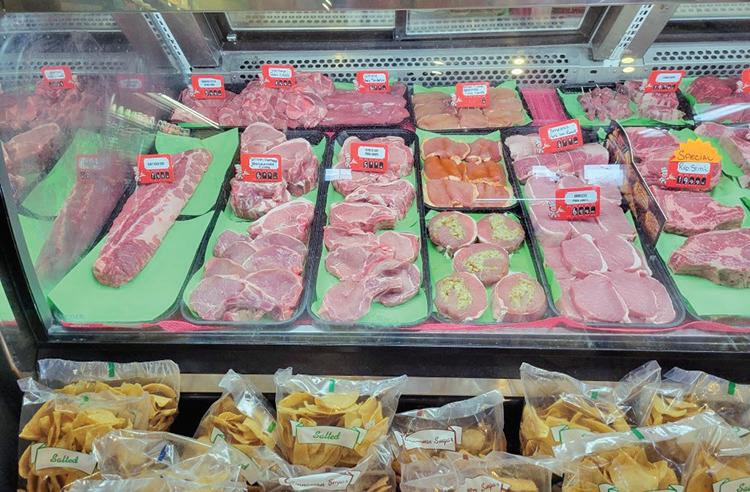
For example, Corman said that the bacon cheddar burger – a grand champion at this year’s Wisconsin Association of Meat Processors awards – remains the top seller at the store. Other popular choices are the pizza burger, and the blue cheese burger with a custom seasoning blend and a high-temperature melt cheese that doesn’t evaporate during cooking.
Flavored brats are also popular, as Wilson offers a Philly Cheesesteak brat with all the elements of the favorite sandwich. Also popular are the MushroomSwiss brat and, as Corman explained, the Cherry brat is “really picking up steam.”
What’s becoming more popular, Corman said, are the seasoned meats. Pre-seasoned chicken and pork – marinated by the store and packaged with the marinade – offer an easy-to-go option.
“So the marinade holds in, helps soak it up,” Corman said.
The store also has pre-seasoned, customblended baby back ribs and spare ribs.
In addition to the store, the upgraded Wilson’s Deli is now open, complete with a bar.
The deli serves lunch Thursday through Saturday and dinner Friday and Saturday.
The deli uses the meats made by the
store to offer up a variety of sandwiches, brats and burgers, as well as beverages and now alcoholic drinks.
A new addition this summer will be the Sunday brunch, which Corman said he hoped would be open by the Fourth of July.
Wilson Farm Meats can be reached at 262-723-2919, or found online at wilsonfarmmeats.com.
SORG’S
Sorg’s Quality Meats and Sausages in Darien offers a full retail counter of fresh meats that are freezer-wrapped for convenience. The family-owned meat processing plant also features a specialty grocery store.
Sorg’s has more than 50 varieties of award-winning brats, as well as sausages and hot dogs that are all homemade using the original family recipe with no MSG.
Sorg’s also offers a wide variety of specialty items from the Al Capone Roast for family gatherings or special occasions, as well as more than 20 varieties of Wisconsin cheese, heat n’eat entrees, homemade meat and gruit pies, a variety of fish, vegetables, pickled products, sauces and seasonings, jams and jellies, homemade meat, and fruit pies as well as a variety of meat snack sticks, jerky, and landjaeger.
Sorg’s is at N4290 Highway 14 in Darien, For more information, call 262724-5554 and visit sorgsmeats.com.
RURALECONOMIES Things everyone can do to support
Efforts to revive small business sectors have helped countless communities regain their prosperity and sense of community pride. Those efforts have been wildly effective in many urban areas, and they also can help rural economies recover from the many challenges they’ve been confronting since the Great Recession, which occurred between 2007 and 2009.
Rural communities have faced many unique challenges since 2007. For example, a 2019 study published in the journal Rural Sociology found that 46% of remote rural counties were depopulating, while just 6% of metropolitan counties were facing population losses.
Reviving rural communities does more than help the people who call those communities home. Thriving rural communities can ensure access to fresh foods for people in both rural and urban areas, thus keeping costs down. Thriving rural communities also can reduce reliance on government assistance programs.
With access to well-paying jobs, more people in rural communities can live above the poverty line. That’s a significant benefit, as the U.S. Department of Agriculture reports that roughly 85% of counties combating persistent poverty are rural.
Attempts to revive rural economies will require a collective effort on the part of people from all walks of life, and there’s much everyone can do to pitch in.
BUY PRODUCTS FROM LOCAL FARMS
When buying foods, looking for products from local farms and/or domestic farms can benefit consumers in various ways.
Many individuals find locally grown foods more flavorful than products imported from foreign countries. And buying local, whether the farm is on the outskirts of the metropolitan area you call home or elsewhere in your own country, provides some much-needed economic stimulation to rural communities.
LOOK BEYOND FOODS
Rural communities produce more than food. Soaps, lotions, candles, decorative items, and other products people use everyday are produced on farms and within rural communities. Choosing these products over mass-produced alternatives made in other countries or in places where profits
Rural economies are struggling. However, there’s much everyone can do to pitch in and support efforts to revive rural communities.
FILE PHOTO Fresh from the Farm
are less likely to be funneled back into local communities is a great way to support rural economies.
SUPPORT LEGISLATION THAT BENEFITS RURAL ECONOMIES

One of the most effective ways to lend a hand to rural economies is to support legislation that can help them. There are many reasons why rural economies have fallen on hard times, and a lack of digital infrastructure has undoubtedly contributed to those struggles.
All businesses benefit from a strong online presence, and communities can attract more remote workers if their digital infrastructure is improved. Those improvements are often the subject of local, state and even federal legislation. Individuals who want to help rural economies can urge their representatives to support legislation that can help rural communities build their digital infrastructure so it’s on par with that which has already been established in more populous areas.
(METRO
CREATIVE)Perks to enjoying raw, local honey
Whether one places a dollop in tea or drizzles some in a yogurt smoothie, honey is the sweet finish that can make various foods and beverages taste that much better. In fact, honey is perhaps Mother Nature’s most natural sweetener.

While honey in any form can provide its share of healthy offerings, raw honey Ñ which is unprocessed and taken straight from a honeycomb Ñ may be even healthier than the alternatives.
According to a 2019 report in Medical News Today, some people believe that processing honey, which often involves pasteurization, removes many of its natural beneficial elements. But honey taken straight from the beehive contains bee pollen, bee propolis and scores of antioxidants.
Individuals interested in trying raw, local honey should consider buying it from a trusted local producer. For those who need more convincing, the following are five beneficial properties of raw honey.
ANTIOXIDANTS
Raw honey contains plant chemicals that act as antioxidants. Healthline says some types of honey have as many antioxidants as fruits and vegetables, which can protect the body from free radicals that damage cells.
ANTIMICROBIAL/ANTIFUNGAL PROPERTIES
Raw honey has antimicrobial properties that could kill certain bacteria, says the Carolina Farm Stewardship Association. That is perhaps why honey long has been used as a natural salve for wounds. Honey can soothe a sore throat, and it also can attack bacteria in the throat responsible for certain illnesses. Healthline says raw honey also has been studied for its use against certain Candida-related infections.
ALLERGY RELIEF
Raw, local honey is made from local flowers and flowering plants. By ingesting raw, local honey regularly, a person is taking in small, manageable doses of allergens from their area, which can help build up an immunity to these allergens over time.
DIGESTIVE RELIEF
Raw honey has been studied for use in treatment for H. pylori bacteria, a common cause of stomach ulcers. Raw honey also may help people overcome diarrhea. Honey contains prebiotics, which nourish good bacteria that live in the gut.
BRAIN HEALTH
A 2017 study published in the journal Pharmacognosy Research found ingredients of honey have anti-inflammatory properties that may help fight inflammation in an area of the brain called the hippocampus, which is responsible for memory.
(METRO CREATIVE)above: Raw, local honey can help protect the environment because the public has a vested interest in maintaining natural spaces and healthy bee populations. Raw, local honey is available from various vendors, notably small operations at farmers markets who take quality control seriously. FILE
How labor shortages are affecting agriculture
`The agricultural workforce is shrinking, and has been for some time. The American Farm Bureau Federation estimates there are roughly 2.4 million farm jobs that need to be filled annually, but there has been a drastic decline in workers each year.
There are a number of reasons for the shortages. The AFBF says more than 73% of farm workers are immigrants from South America and Mexico. While the United States’ H2-A visa program, which allows employers who meet specific requirements
to bring foreign laborers in for temporary work, has increased the number of accepted applications for immigrants to 250,000, this number is still just a drop in the bucket in terms of labor needs.
Another factor is a career in agriculture isn’t always easy or lucrative. According to the U.S Department of Agriculture, for every dollar spent on food, a farmer receives only 7.6 cents. Farmers were predicted to lose 9.7% of total net income in 2021.
Declining interest in the field has also affected the number of farm workers. As more farm operators reach retirement age, fewer young farmers are replacing them due to volatile pricing, high real estate and land costs, steep initial machinery investment costs, and other factors.
The physical demand of the industry also takes its toll. So what does this mean for the agricultural industry?
Many with knowledge of the industry indicate sweeping changes are warranted. Ellen Poeschi, the project director for the National Association of Agricultural Educators Teach Ag campaign, has said that a lack of agricultural education is contributing to the problem.
Increasing availability of ag education
courses across the country could build interest in the industry. Connecting students to internships or mentors may help, too.
Another option is to rally for greater economic opportunities in agriculture. The ag industry in general needs to find ways to make the economic benefits more competitive to other industries, and improve the working conditions and job flexibility.
Agricultural industries currently average only 60% of what other industries offer in salaries. Farm wages have been rising due to the H-2A program, which requires farm worker pay to be higher than the state/ federal minimum wage. More change is needed, but this may have to come at the federal level or be sparked by efforts on the part of agricultural advocacy groups.
Additional strategies farm operators can employ to combat shortages are: scaling back farm operations; integrating ag technology to reduce labor burdens; pivoting to crops that require fewer laborers; leasing portions of land to have extra money; employing temporary guest workers; and moving operations abroad.
 (METRO CREATIVE)
(METRO CREATIVE)




